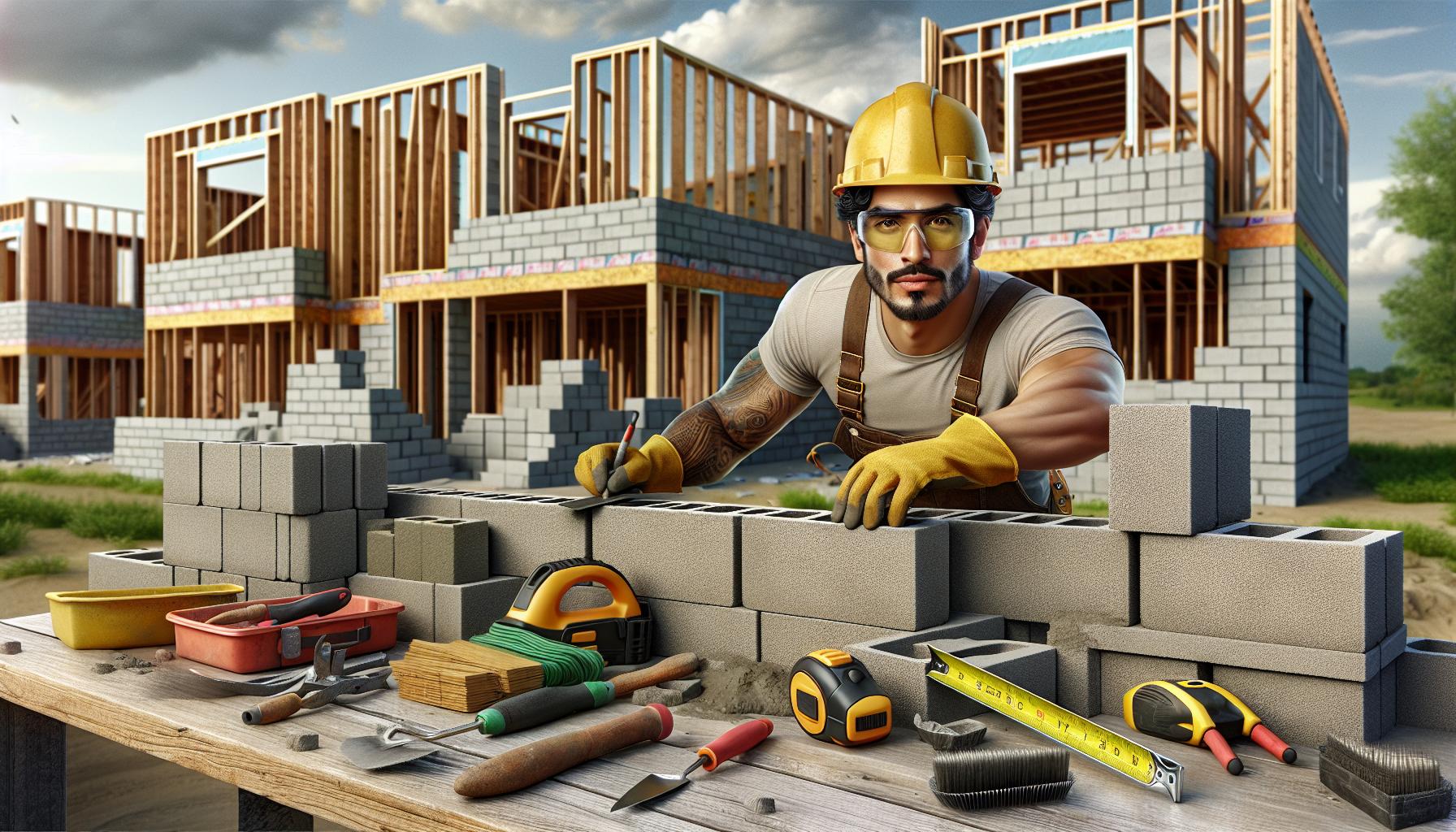Building a hollow block wall offers a sturdy and cost-effective solution for various construction projects. This article guides readers through the essential steps, from selecting the right materials to ensuring proper alignment and stability. Whether it’s for a garden boundary or a structural support, mastering this technique can improve any DIY skill set and lead to impressive results.
Overview of Hollow Block Walls
Hollow block walls consist of individual concrete blocks featuring hollow centers, providing strength and insulation. Commonly used in residential and commercial construction, these walls offer benefits such as durability, cost-effectiveness, and ease of installation.
Hollow blocks, typically made from a blend of cement and aggregates, vary in size. Standard dimensions include 8 inches by 8 inches by 16 inches, but builders can find different sizes to meet specific project needs. The hollowness lowers the wall’s weight, which aids transport and handling.
These walls excel in thermal and acoustic insulation, enhancing energy efficiency and reducing noise. Maintenance remains minimal due to the durable materials used, making them suitable for various climates and conditions. The ease of construction allows for efficient stacking and alignment, which can expedite project timelines.
For structural applications, hollow block walls create sturdy support for roofs and upper levels, contributing to overall structural integrity. Proper reinforcement during construction, such as steel rods or mesh, is vital to improve stability, particularly in areas prone to seismic activity.
Understanding local building codes ensures compliance and safety in hollow block wall construction. This knowledge helps in selecting appropriate materials and techniques for effective implementation.
Materials Needed

Building a hollow block wall requires specific materials and tools to ensure durability and effectiveness. The following sections outline types of hollow blocks and necessary tools.
Types of Hollow Blocks
- Standard Hollow Blocks: Commonly sized at 8 inches by 8 inches by 16 inches, these blocks serve well in most construction applications due to their structural integrity.
- Lightweight Hollow Blocks: Made from lighter aggregates, these blocks reduce transport costs and are easier to handle, ideal for projects requiring reduced load-bearing capacity.
- Insulated Hollow Blocks: Designed with built-in insulation, these blocks improve thermal efficiency, suitable for energy-efficient buildings.
- Decorative Hollow Blocks: Available in various designs and textures, these blocks provide aesthetic appeal, often used in garden walls or decorative boundaries.
Tools Required
- Trowel: Used for applying mortar precisely between blocks.
- Level: Ensures each block aligns correctly to maintain a straight wall.
- Concrete Mixer: Mixes mortar and concrete efficiently, saving time on larger projects.
- Measuring Tape: Verifies dimensions for accurate placements during construction.
- Chisel and Hammer: Helps in trimming blocks for precise fitting, especially around corners and openings.
- Safety Gear: Includes gloves, goggles, and a dust mask to protect against dust and debris during construction.
Preparing the Site
Preparing the site for a hollow block wall involves careful assessment and precise measurements. Proper site preparation ensures stability and durability.
Site Assessment
Start by evaluating the chosen location for the wall. Check for any obstacles, such as trees, existing structures, or utility lines. Inspect the soil to ensure it can support the wall’s weight. Consider drainage issues that could affect the wall’s integrity. Nearby structures must also be noted to ensure compliance with local building codes.
Measuring and Marking
Use a measuring tape to determine the wall’s desired length and height. Mark the boundaries with stakes and string; this creates a visual guide for placement. Ensure measurements align accurately with plans. Double-check diagonal measurements to confirm squareness. This step prevents misalignment during construction, maintaining the wall’s integrity.
Building the Hollow Block Wall
Constructing a hollow block wall requires methodical planning and execution. This process ensures stability and durability.
Laying the Foundation
The foundation provides essential support for the hollow block wall. Start with a clear and leveled area, ensuring it’s free from obstacles such as roots and debris. Dig a trench that is at least 12 inches deep and 24 inches wide, allowing ample space for the foundation. Fill the trench with a mixture of gravel and concrete for a solid base. Compact the material to minimize settling. Once the foundation is set and cured for at least 48 hours, check for levelness before proceeding.
Mortar Application Techniques
Applying mortar correctly is vital for the wall’s integrity. Mix the mortar to a thick consistency, achieving a paste-like texture that adheres well to blocks. Use a trowel to apply a uniform layer of mortar on the foundation and the ends of the blocks. Ensure a mortar bed thickness of about 1 inch. Implement the “buttering” technique by applying mortar to both sides of the block for better adhesion. Avoid excessive mortar that can overflow when blocks are placed, as this can weaken the bond.
Block Placement Method
Placing the blocks accurately affects the overall stability of the wall. Start at a corner or end, positioning the first block against the mortar bed. Use a level to ensure it sits straight and even. Fill the space between the blocks with mortar as they’re laid, maintaining consistent joints of 3/8 inch. Stagger the joints by offsetting each row from the one below it, enhancing structural integrity. Tapping blocks into place with a rubber mallet helps achieve a secure fit without damaging the surfaces.
Finishing Touches
Finishing touches improve the durability and aesthetics of a hollow block wall. Two critical aspects are surface treatment options and proper curing and maintenance.
Surface Treatment Options
Several surface treatments improve both the appearance and longevity of a hollow block wall.
- Painting: A high-quality exterior paint adds color and weather resistance. It helps protect against moisture and UV damage.
- Sealing: Waterproof sealants create a barrier against water infiltration. This treatment prevents mold and mildew growth.
- Plastering: Adding a layer of plaster provides a smooth finish. It also enhances thermal insulation and provides a ready surface for painting.
- Stucco: Applying stucco offers a textured finish. Stucco is durable and allows for customization in color and design.
Each of these options serves specific purposes, contributing to the wall’s overall performance and visual appeal.
Curing and Maintenance
Curing is essential for achieving the maximum strength of the hollow block wall.
- Curing Process: Maintain moisture around the wall for at least seven days after construction. Use wet burlap or plastic sheeting to retain moisture during this period.
- Regular Inspections: Inspect the wall regularly for cracks or signs of damage. Immediate repair prevents further issues.
- Cleaning: Remove dirt and debris, which can trap moisture. Use a mild detergent and a soft brush for cleaning.
- Repaint or Reseal: Renew paint or sealant every few years, ensuring continued protection against the elements.
Implementing these steps ensures the hollow block wall remains structurally sound and visually appealing over time.
Conclusion
Building a hollow block wall is a rewarding project that combines practicality with aesthetic appeal. With the right materials and techniques anyone can create a sturdy structure that stands the test of time. Proper site preparation and careful attention to detail during construction are vital for achieving optimal results.
By following the outlined steps and considering factors like insulation and reinforcement it’s possible to improve both the functionality and beauty of the wall. Regular maintenance and finishing touches will ensure the wall remains attractive and durable for years to come. Embracing this construction method not only boosts DIY skills but also contributes to efficient and lasting building practices.
Frequently Asked Questions
What are the benefits of building a hollow block wall?
Building a hollow block wall offers several benefits, including durability, cost-effectiveness, and ease of installation. The hollow centers of the blocks provide good insulation, reducing energy costs, while their lightweight nature makes handling and transport easier. Additionally, these walls require minimal maintenance, making them an economical choice for various construction needs.
What are the standard dimensions of hollow blocks?
The standard dimensions of hollow blocks are typically 8 inches by 8 inches by 16 inches. These dimensions offer a balance between strength and ease of handling, making them ideal for building durable walls while ensuring the blocks are manageable for DIY projects.
What tools do I need to build a hollow block wall?
To build a hollow block wall, you’ll need essential tools like a trowel, level, concrete mixer, measuring tape, chisel, hammer, and safety gear. These tools will help ensure accurate measurements, proper mortar application, and a safe building process.
How do I prepare the site for a hollow block wall?
Site preparation involves assessing the location for obstacles, inspecting the soil for support, and considering drainage issues. Precise measurements are crucial, so use stakes and string to mark out the area, which ensures accurate alignment and stability for the hollow block wall.
What is the proper way to lay a foundation for a hollow block wall?
Begin by digging a trench for the foundation, filling it with gravel and concrete. Once the concrete has cured, check for levelness to ensure a stable base. A well-laid foundation is essential for the overall integrity and longevity of the hollow block wall.
How do I apply mortar when building a hollow block wall?
When applying mortar, achieve the right consistency and use the “buttering” method to ensure better adhesion between blocks. Apply mortar to the top and sides of each block to create a solid bond. Consistency is key to a strong wall.
How can I enhance the durability and aesthetics of a hollow block wall?
To enhance durability and aesthetics, consider surface treatments like painting, sealing, plastering, or stucco. These treatments not only improve the visual appeal but also protect the wall from weather elements and ensure long-lasting performance.
Why is curing and maintenance important for a hollow block wall?
Curing and maintenance are crucial for the longevity of a hollow block wall. Proper curing strengthens the mortar, while regular inspections and cleaning help identify any issues early. Repainting or resealing over time protects the wall and maintains its visual appeal.



